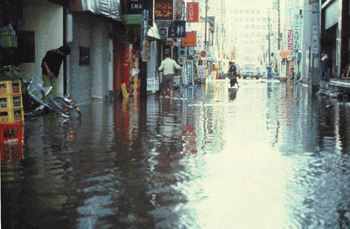
By Diana Balmonte
Tokyo is the capital city of Japan and is a densely populated megacity located in the approximate center of the Japanese archipelago. The population of Tokyo is 12.989 million (Tokyo Metropolitan Government, 2010). The region of Tokyo is composed of four prefectures: Tokyo, Chiba, Saitama, and Kanagawa. Once the population of these neighborhoods is taken into account, Tokyo’s overall population swells to 35 million (Tokyo Metropolitan Government, 2010). This area is home to 28% of Japan’s population. A climate risk assessment (Mehrotra et al., 2009) of the water sector in Tokyo shows many reasons for concern as the city moves into a future characterized by shifting climate patterns. An analysis of the climate risks facing the water sector in the city is outlined below, followed by recommendations for dealing with risk and operationalizing solutions.
Tokyo’s water system is among the largest in the world (Bureau of Waterworks, 2010). Tokyo is affected by water in many ways. The greater Tokyo region rests in an alluvial flood plain and is bounded on one side by Tokyo Bay. There are five primary rivers that flow through the Tokyo basin: the Tonegawa, Arakawa, Tamagawa, Sagamgawa, and Tsurumigawa. This area is flood prone and sits at a low elevation. Approximately 1.5 million of Tokyo’s residents reside below sea level (Carmin, 2011).
Flooding is a concern for several reasons. Regional weather patterns have a four-season cycle, which can include typhoons (UNESCO, 2003). Japan is also prone to earthquakes, which can trigger tsunamis. Climate change has altered rainfall; while total precipitation has been decreasing, the amount of rain that falls in one period has increased.
Additional climate change challenges are rising sea levels, increasing temperatures, and droughts. Increased heat waves will further worsen Tokyo’s already considerable heat island effect. Due to these diverse challenges water use is expected to increase, while Tokyo is experiencing land subsidence from decreasing water tables (UNESCO, 2003).
Japan has high quality infrastructure and is able to address many of these challenges. The greater Tokyo region draws its water from an elaborate system of dams and reservoirs. Tokyo Waterworks incorporates climate change plans in its policy and implements mitigation and adaptive measures (Bureau of Waterworks, 2010). Some of its current tactics are solar-powered water filtration plants, hydraulic power stations run by renewable energy sources, preservation and restoration of watershed areas, and overall reduction of leakages (Bureau of Waterworks, 2010). Tokyo also uses several strategies to combat flooding by building massive underground containment silos and widening sewer lines (Tokyo Metropolitan Government, 2010). Another primary source of flood control are super-levees. These are constructed along flood-prone rivers and can withstand earthquakes, flash floods, and surges (Atsumi, 2009).
Four primary recommendations emerge from this analysis. Japan is a country with well-developed infrastructure and technological resources. The nation should use its considerable expertise to aid its less affluent neighbors to develop comprehensive climate change mitigation and adaptive strategies. The region of Tokyo will need to create a multi-faceted system for water-banking to address potential water shortages; reusing storm water for non-drinkable needs is an obvious solution. Flooding will remain a constant challenge, and Tokyo will always have to remain alert and innovative to address this issue. Lastly, Tokyo should scale-up its efforts to restore its surrounding ecosystems, with co-benefits for water supply and public health.
References
Atsumi, Masahiro. (2009, January). River Management in Japan, with a focus on river levee. Retrieved November 7th, 2011, from http://www.mlit.go.jp/river/basic_info/english/pdf/conf_20.pdf
Carmin, JoAnne. (2011). Preparing Cities for Climate Change: An International Assessment of Urban Adaptation Planning. Retrieved October 4th, 2011, from http://web.mit.edu/jcarmin/www/urbanadapt/index.htm
Mehrotra, S., C.E. Natenzon, A. Omojola, R. Folorunsho, J. Gilbride & C. Rosenzweig. (2009). Framework for city climate risk assessment. Washington, DC: World Bank.
Tokyo Metropolitan Government. (2006-2011). City Profile. Retrieved October 4th, 2011, from http://www.metro.tokyo.jp/ENGLISH/index.htm
UNESCO. (2003, March 22). Greater Tokyo, Japan. Retrieved October 4th, 2011, from http://www.unesco.org/water/wwap/case_studies/tokyo/tokyo_basin.pdf
Waterworks, Bureau of. (2010). Climate change projections and actions for the future, Tokyo Case Study. Retrieved October 4th, 2011, from http://www.waterprofessionals.metro.tokyo.jp/pdf/Climate_Change_Projection_and_Actions_for_the_Future_Tokyo_Case_Study.pdf
This article is a product of Professor Shagun Mehrotra’s Climate Change and Cities class. Views expressed are entirely those of the individual author.